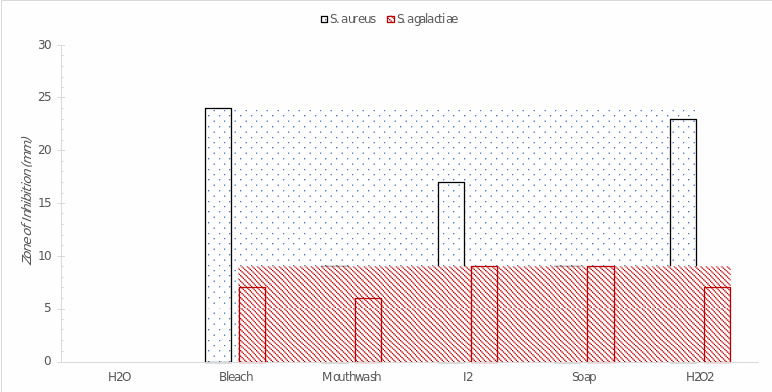Introduction
S. aureus and S. agalactiae are pathogens that are found in many environments, including those associated with the human body, capable of causing infections ranging from mild to health hazards. Inhibiting of microbial growth with antiseptic drugs is a preventive public health measure (Stathis et al., 2021). In the present laboratory work, inhibition patterns were studied with a variety of reagents, from distilled water to bleach to hydrogen peroxide. The study provides valuable practical knowledge about laboratory skills as well as the effects of antiseptic agents on the growth of S. aureus and S. agalactiae.
Hypothesis
The first hypothesis of the experiment was that both culture lines would show similar patterns of growth inhibition depending on the application of the chemicals. The second hypothesis was that of all the reactants, bleach showed the best inhibition results.
Methods
The methodological basis for the present laboratory work was an experiment performed virtually on the MH Connect platform. Two cultures, S. aureus and S. agalactiae, were applied independently with care to two agar plates. Chemicals claiming to inhibit growth, namely distilled water, bleach, Mouthwash, iodine, soap, and hydrogen peroxide, were also applied to each of the plates using a sterile cotton pipette. Both plates were incubated for one day at 37°C, after which the diameters of the inhibition spot for each culture, depending on the applied chemical, were estimated using a measuring ruler (Table 1). The results were processed to determine the effect of the different reagents on cell culture growth inhibition.
Results
Table 1 shows the results of inhibition spots for the two cell cultures: a larger number corresponds to a more robust growth inhibition mechanism. These data were visualized (Figure 1) for a simplified comparison. As can be seen, distilled water had no effect on growth inhibition. At the same time, the results differed for the two cultures. For S. aureus, bleach and hydrogen peroxide showed better growth inhibition, whereas, for S. agalactiae, the best results were shown for iodine and soap.
Table 1. Results of direct measurements of inhibition zones

Conclusion
The laboratory work was aimed at investigating the effect of different chemicals on the growth inhibition of two cell cultures, S. aureus and S. agalactiae. The results demonstrated that growth inhibition was dissimilar for the two bacteria, which refuted the first hypothesis. The second hypothesis was also not confirmed because the bleach was effective only for S. aureus, but for S. agalactiae the reagent had no better effect. Thus, it has been shown that different cell lines respond differentially to different media. It follows that in order to effectively contain the pathogenic influence of microorganisms, their behavior must be carefully studied.
Reference
Stathis, C., Victoria, N., Loomis, K., Nguyen, S. A., Eggers, M., Septimus, E., & Safdar, N. (2021). Review of the use of nasal and oral antiseptics during a global pandemic. Future Microbiology, 16(2), 119-130. Web.